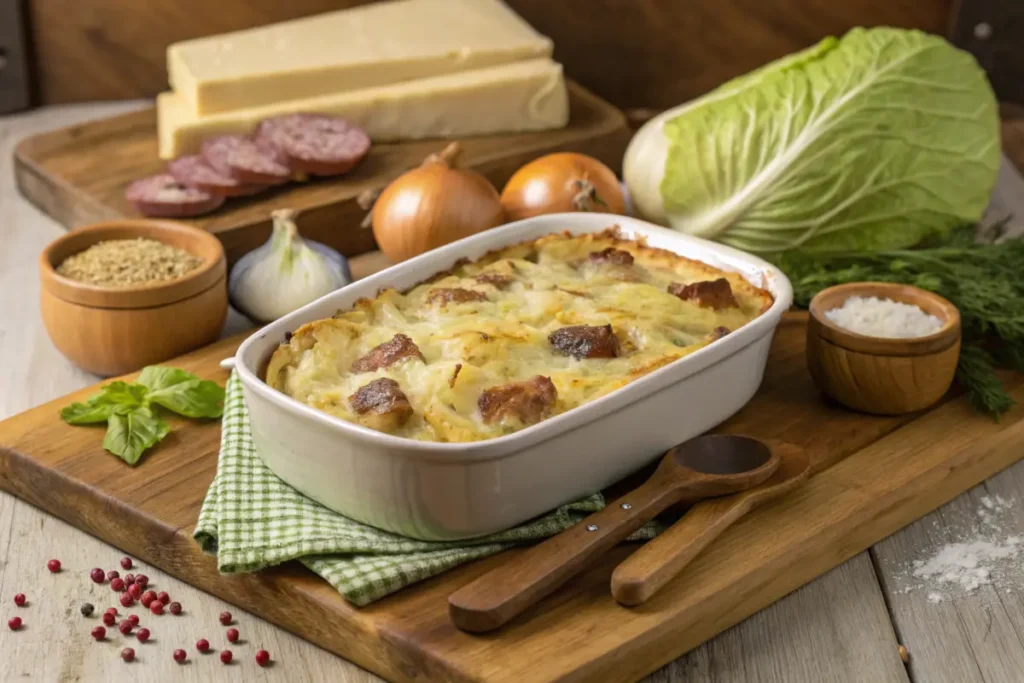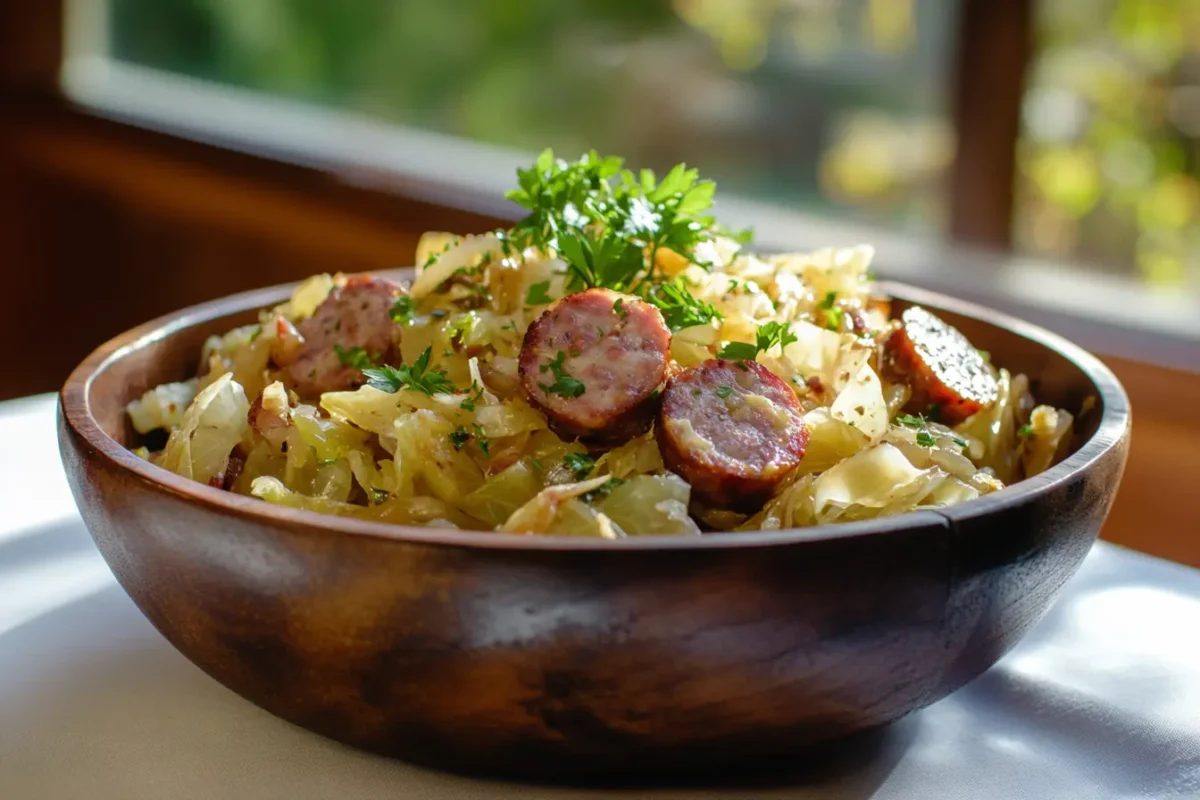If you’re on a low-carb or keto diet—or just keeping a close eye on your daily carb intake—you’ve probably wondered: How many carbs are in cabbage and sausage? This savory combo is a staple in many kitchens, thanks to its bold flavors and versatility. Whether you’re crafting a hearty stir-fry or a warming casserole, understanding the nutritional breakdown is key to making informed dietary choices.
In this article, we’ll dive deep into the nutritional profile of cabbage and sausage, explore how their carbohydrate content varies by preparation, and uncover tips for enjoying this duo as part of a balanced diet. Stick around for recipes, FAQs, and health tips that’ll satisfy your curiosity and your appetite!
Nutritional Profile of Cabbage and Sausage
What is Cabbage? Nutritional Overview
Cabbage is a cruciferous vegetable packed with essential nutrients like vitamins C and K, as well as minerals like potassium. This leafy green is known for its low-carb content—a raw, one-cup serving has just about 5 grams of carbs, 2 grams of which are dietary fiber. That makes cabbage a fantastic choice for low-carb diets, offering a boost of nutrients without weighing you down in carbs.
Did you know that cabbage also contains antioxidants like sulforaphane? These compounds have been linked to various health benefits, including reduced inflammation and improved digestion.
Sausage Varieties and Their Nutritional Differences
When it comes to sausage, the nutritional value varies greatly depending on the type and ingredients. Traditional pork sausage tends to be higher in fat, while chicken or turkey sausages are often leaner. However, carbohydrates can sneak into sausage through added fillers, such as breadcrumbs, starches, or sweeteners.
For example:
- A typical smoked sausage contains about 2–3 grams of carbs per link.
- Specialty sausages, like those flavored with maple syrup or apples, might contain up to 10 grams of carbs per serving.
Choosing low-carb sausage options like all-meat varieties or those labeled keto-friendly can help keep carb intake in check.
Key Nutritional Benefits of Combining Cabbage and Sausage
Pairing cabbage and sausage isn’t just about flavor—it’s also a smart nutritional move. Cabbage provides a hefty dose of fiber, helping with digestion and stabilizing blood sugar levels. Meanwhile, sausage contributes protein and fat, making this combo a well-rounded, low-carb meal option.
The best part? Both ingredients are incredibly versatile. Whether you’re sautéing them together for a quick stir-fry or simmering them in a soup, they complement each other beautifully while keeping the carb count manageable.
Carbohydrate Content in Cabbage
Raw vs. Cooked Cabbage: A Comparison
Cabbage is a naturally low-carb vegetable, making it a favorite for people managing their carb intake. In its raw form, one cup of shredded green cabbage contains about 5 grams of carbs, of which 2 grams are dietary fiber, leaving only 3 grams of net carbs. Cooking cabbage can slightly alter its carb content due to changes in water retention, but the difference is minimal.
When boiled or steamed, cabbage retains its low-carb profile, making it an excellent addition to keto and low-carb diets. However, frying cabbage with oils or adding sweeteners can significantly increase its calorie and carb count, so it’s essential to watch those extras.
To learn about different preparation methods, you can explore this guide to cooking cabbage and sausage.
Cabbage’s Role in a Low-Carb Diet
Cabbage isn’t just low in carbs—it’s also rich in fiber, which helps regulate blood sugar levels and supports healthy digestion. Whether eaten raw in salads or sautéed with garlic, this vegetable is a versatile, nutrient-dense food for anyone following a low-carb lifestyle. Plus, its affordability and availability make it a kitchen staple.
Pairing cabbage with low-carb proteins, like sausage, creates a meal that’s satisfying and diet-friendly. Not sure how to complement cabbage dishes? Check out great side dishes for kielbasa and cabbage for inspiration.
Understanding Natural Sugars and Fiber in Cabbage
Cabbage contains natural sugars, but its high fiber content offsets this, resulting in a lower net carb value. Fiber not only slows digestion but also keeps you feeling full longer, which can aid in weight management. Red and Savoy cabbages have similar carb counts but provide a slightly different nutrient profile, giving you options to match your taste and diet needs.
Carbohydrate Content in Sausage
Types of Sausage and Their Carb Content
Not all sausages are created equal when it comes to carbs. Traditional sausages like bratwurst and Italian sausage typically have around 2–3 grams of carbs per serving, while flavored sausages, such as maple or apple varieties, can climb as high as 10 grams. For carb-conscious eaters, it’s vital to read labels and opt for sausages made without fillers or sweeteners.
Low-carb or keto-friendly sausages often highlight their carb content on the packaging, making it easier to choose the right product for your dietary goals. This is especially crucial when planning meals featuring low-carb ingredients like cabbage.
Additives in Sausage: Hidden Carbs to Watch For
Some sausages include additives like breadcrumbs, cornstarch, or dextrose, which can quietly increase the carbohydrate count. These hidden carbs can derail a low-carb diet if not accounted for. To avoid surprises, select sausages with simple, natural ingredients, and always double-check the nutrition label.
Low-Carb Sausage Options for Diet-Conscious Individuals
For those following a ketogenic diet, there are plenty of low-carb sausage brands available. Chicken and turkey sausages tend to be leaner and lower in carbs compared to pork varieties. Smoked or cured sausages can also be good options if they’re free of sugary marinades.
Wondering which meat pairs best with cabbage? Discover tips in what meat is best for cabbage.
Combining Cabbage and Sausage in Recipes
Popular Cabbage and Sausage Recipes: A Nutritional Breakdown

One of the best ways to enjoy cabbage and sausage is by incorporating them into hearty, flavorful recipes. Classic dishes like cabbage stir-fry with smoked sausage or baked cabbage and sausage casserole offer a satisfying blend of textures and tastes. But how many carbs are in cabbage and sausage when cooked together?
For example, a simple stir-fry made with one cup of shredded cabbage and one sausage link results in a low-carb meal. Additionally, adding butter or olive oil for flavor doesn’t significantly increase the carb count, but it does enhance the richness of the dish. As a result, this combination remains a favorite among low-carb enthusiasts.
Want to try a specific recipe? Check out this step-by-step guide on cabbage and sausage recipes for inspiration.
How Cooking Methods Affect Carbohydrate Levels
Cooking cabbage and sausage together brings out their natural flavors but can change their nutrition. Frying or roasting might add more calories and carbs if you use sauces or breading. Conversely, steaming or boiling helps retain the nutrients in cabbage while keeping the carb count minimal.
For those on a keto or low-carb plan, sautéing cabbage in olive oil with sausage is an ideal cooking method. It’s fast, flavorful, and keeps the carb count low—perfect for weeknight meals.
Meal Ideas for Low-Carb Diets Featuring Cabbage and Sausage

Here are a few creative ways to enjoy cabbage and sausage without exceeding your carb goals:
- Cabbage Stir-Fry with Garlic Sausage: Sauté shredded cabbage, smoked sausage, and garlic for a quick, savory dish.
- Low-Carb Cabbage Soup: Combine cabbage, sausage, and a rich broth for a warming, keto-friendly meal.
- Baked Cabbage Casserole: Layer cabbage, sausage, and cheese for a delicious, low-carb comfort food.
For more low-carb recipes, check out the recipe section.
Health Impacts of Carbohydrates in Cabbage and Sausage
Balancing Macronutrients for Optimal Health
Cabbage and sausage aren’t just a tasty pairing—they can also contribute to a balanced diet when prepared thoughtfully. Cabbage offers fiber and essential nutrients, while sausage adds protein and healthy fats. This combination supports stable energy levels and aids in digestion, making it an excellent choice for low-carb lifestyles.
However, balance is key. Sausage can be high in sodium and saturated fat, so it’s essential to choose leaner options and pair them with plenty of fresh veggies like cabbage.
How Low-Carb Foods Support Weight Loss Goals
Low-carb meals like cabbage and sausage can help with weight management. Eating fewer carbs helps control blood sugar levels and may help your body burn fat for energy. By including fiber-rich cabbage, you also promote satiety, which helps curb hunger.
For more dietary tips, check out other articles in the low-carb recipes collection.
The Role of Cabbage and Sausage in a Keto Diet
Cabbage and sausage fit beautifully into a ketogenic diet, which prioritizes high-fat, low-carb foods. Cabbage’s low carb count and sausage’s fat content make them a dynamic duo for staying in ketosis. Just be mindful of the type of sausage you use to avoid hidden carbs.
Not only do low-carb meals like cabbage and sausage support weight management, but they also help regulate blood sugar levels. Furthermore, Eating fewer carbs helps control blood sugar and may help the body burn fat for energy.
FAQs: Addressing Common Questions About Cabbage and Sausage
Can You Eat Cabbage and Sausage on a Keto Diet?
Yes, absolutely! Cabbage and sausage are keto-friendly foods when prepared without carb-heavy additives. A typical dish featuring these two ingredients can be as low as 7–10 grams of carbs per serving. To ensure the meal remains keto, focus on using high-quality sausage without fillers and skip ingredients like breadcrumbs or sugary marinades. The question, how many carbs are in cabbage and sausage, depends largely on your recipe, so keep it simple for the best results.
How Does Cabbage Compare to Other Vegetables in Carbohydrate Content?
Cabbage is one of the lowest-carb vegetables, with just 5 grams of total carbs per cup when raw. In comparison, starchy vegetables like potatoes or sweet corn can contain over 20 grams of carbs per cup. This makes cabbage an excellent substitute in recipes for those watching their carb intake. Cooking methods that don’t involve high-carb sauces or breading keep cabbage’s carb content minimal.
What Are the Best Sausage Options for a Low-Carb Lifestyle?
For those following a low-carb or keto plan, opt for sausages labeled as “keto-friendly” or “all-meat.” Look for options with less than 2 grams of carbs per serving and avoid varieties with sugary glazes or fruit-based flavors. Smoked or spicy sausages often have fewer carbs and pair perfectly with cabbage dishes.
Does Cooking Cabbage and Sausage Together Increase Carbs?
Cooking cabbage and sausage together doesn’t inherently increase their carb content unless you add extra ingredients like sugary sauces, potatoes, or other starches. Sauteing the duo with olive oil, garlic, and spices keeps the carb count low and enhances the natural flavors of the dish. To maintain a low-carb profile, always use fresh ingredients and minimal seasonings with added sugar.
Conclusion and Practical Tips
Summary of Carb Content in Cabbage and Sausage
To wrap it up, how many carbs are in cabbage and sausage? When paired in a simple recipe, this meal offers a low-carb, high-nutrient option. With cabbage containing around 5 grams of carbs per cup and most sausages averaging 2–3 grams per link, this dish is ideal for anyone on a keto or low-carb diet. By choosing the right ingredients and preparation methods, you can enjoy a flavorful, satisfying meal without worrying about excess carbs.
Quick Tips for Incorporating Cabbage and Sausage into Your Diet
- Keep it simple: Use fresh cabbage and low-carb sausages to maintain a minimal carb count.
- Experiment with spices: Add garlic, paprika, or Italian herbs for more flavor without adding carbs.
- Batch cook: Prepare large portions of cabbage and sausage dishes for quick, low-carb meals throughout the week.
- Pair with other low-carb sides: Serve with cauliflower rice or zucchini noodles for a complete meal.
For more delicious and healthy recipes, check out the recipe collection.
How Many Carbs Are in Cabbage and Sausage? Practical Examples
Real-Life Carb Counts in Cabbage and Sausage Dishes
Understanding how many carbs are in cabbage and sausage becomes even easier when we look at real-life examples. For instance, a simple stir-fry made with one cup of shredded cabbage (3 net carbs) and one sausage link (2 carbs) results in a low-carb meal totaling approximately 5–6 grams of carbs per serving. Adding butter or olive oil for flavor doesn’t significantly increase the carb count but enhances the dish’s overall richness.
On the other hand, a cabbage and sausage casserole that includes breadcrumbs or potatoes can contain up to 20 grams of carbs per serving. The key is to choose your ingredients wisely and stick to low-carb additions like cheese, cream, or keto-friendly seasonings.
Comparing Home-Cooked and Restaurant Versions
If you’re eating out, cabbage and sausage dishes might contain unexpected carbs from sauces, thickeners, or hidden fillers. Home-cooked versions are a safer bet since you control the ingredients. Restaurants often use added sugars or starch-based thickeners to enhance flavor or consistency, so always ask about preparation methods before ordering.
Cooking at home not only lets you monitor carb content but also saves money and allows you to customize flavors. A classic example is frying cabbage in bacon grease and pairing it with sausage—keeping it keto and absolutely delicious!
The Versatility of Cabbage and Sausage in Meal Planning
Adapting Cabbage and Sausage for Different Diets
Cabbage and sausage isn’t just for low-carb enthusiasts—it can fit into various dietary lifestyles with a few tweaks:
- For keto diets: Stick to fatty sausages and add butter or cheese for richness.
- For paleo diets: Use all-natural, nitrate-free sausages and avoid processed seasonings.
- For gluten-free diets: Double-check sausage labels for gluten-containing fillers or opt for certified gluten-free products.
This dish’s adaptability makes it a go-to for families with diverse dietary needs.
Tips for Using Leftovers Creatively
Got leftover cabbage and sausage? Repurpose them into new dishes to reduce waste and keep meals exciting. Here are some ideas:
- Cabbage and sausage soup: Add chicken broth and a splash of cream for a comforting, low-carb soup.
- Stuffed cabbage rolls: Wrap leftover cabbage leaves around sausage pieces for an easy snack or dinner.
- Low-carb stir-fry: Mix leftovers with other low-carb veggies like zucchini or bell peppers for a quick meal.
By using versatile, budget-friendly ingredients like cabbage and sausage, you can stretch your meal plan and reduce time spent in the kitchen.

